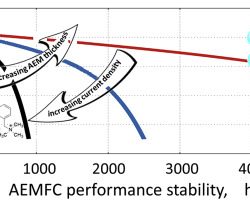Effect of Ammonium Cations on the Diffusivity and Structure of Hydroxide Ions in Low Hydration Media
Authors : Israel Zadok, Dario R Dekel, Simcha Srebnik
Anion exchange membrane (AEM) fuel cells are an attractive alternative technology to the acidic proton exchange membrane-based fuel cells. Conduction of hydroxide ions in AEMs creates an alkaline operating environment that allows using platinum-free catalysts, while still maintaining the performance needed for commercial application (e.g., the automotive industry). However, this technology is very sensitive to the behavior of hydroxide ions under low hydration conditions because of the consumption of water near the cathode. We use molecular dynamics simulation to investigate the behavior of two model quaternary ammonium cations used in AEM technologies




